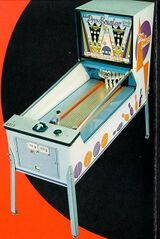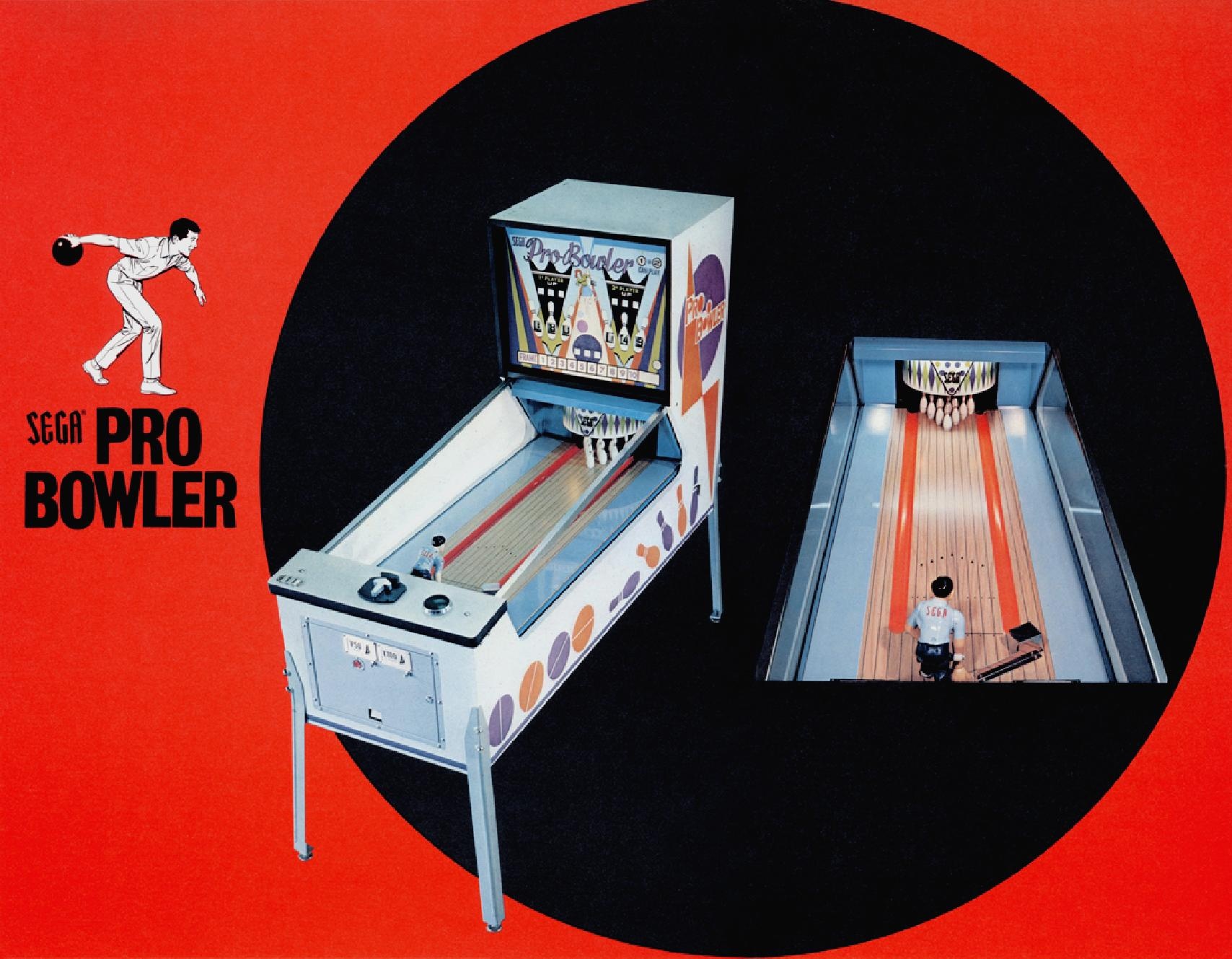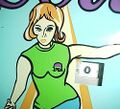Difference between revisions of "Pro Bowler"
From Sega Retro
| (7 intermediate revisions by 4 users not shown) | |||
| Line 1: | Line 1: | ||
{{Bob | {{Bob | ||
| − | | | + | | image=ProBowler JP front.jpeg |
| − | | publisher=[[Sega]] | + | | publisher=[[Sega Enterprises, Ltd.]] |
| − | | developer=[[Sega]] | + | | developer=[[Sega Enterprises, Ltd.]] |
| − | | system= | + | | system=Electro-mechanical arcade |
| players=2 | | players=2 | ||
| genre= | | genre= | ||
| releases={{releasesArcade | | releases={{releasesArcade | ||
| + | | em_date_jp=1972{{ref|https://web.archive.org/web/20230819003054/http://thetastates.com/eremeka/1970s.html}}{{fileref|SEGA Price List 1972-09-01 JP.pdf|page=6}} | ||
| + | | em_rrp_jp=420,000{{fileref|SEGA Price List 1972-09-01 JP.pdf|page=6}}{{fileref|1977SegaPriceList JP.pdf|page=7}} | ||
| em_date_us=1972 | | em_date_us=1972 | ||
| − | |||
}} | }} | ||
}} | }} | ||
| − | {{sub-stub}}'''''{{PAGENAME}}''''' (プロボウラー) is a 1972 two-player electro-mechanical bowling game manufactured by [[Sega]] | + | {{sub-stub}}'''''{{PAGENAME}}''''' (プロボウラー) is a 1972 two-player electro-mechanical arcade bowling game manufactured by [[Sega Enterprises, Ltd.]] The game is a mechanically animated manikin bowling game and basically a copy of Williams' ''Mini Bowl'' (8/70). ''Pro Bowler'' has a five-foot playfield length and scores just like regulation bowling. Relays in this Sega game are the enclosed and socketed variety. Note the drawing date on the schematics for ''Pro Bowler'' is 1972, but reportedly this game was made as late as 1976. Top glass size is 22" x 44.5” x 3/16” tempered glass. It uses one pinball 1 1/4" diameter glass. |
The game has a few technical problem (aside from the usual manikin game troubles). One is the transformer is not as robust as American-made games. This is the problem for the G.I. (General Illumination, 6.3 volts). If all the bulbs are installed for the game, only about 4.3 volts is available. As bulbs are removed, the voltage goes up (indicating the transformer can't supply the necessary current to light all the bulbs!) Another problem are the relays themselves. The plug/socket arrangement can be trouble, as the male plugs on the relays turn brown and don't conduct. These can be cleaned though. | The game has a few technical problem (aside from the usual manikin game troubles). One is the transformer is not as robust as American-made games. This is the problem for the G.I. (General Illumination, 6.3 volts). If all the bulbs are installed for the game, only about 4.3 volts is available. As bulbs are removed, the voltage goes up (indicating the transformer can't supply the necessary current to light all the bulbs!) Another problem are the relays themselves. The plug/socket arrangement can be trouble, as the male plugs on the relays turn brown and don't conduct. These can be cleaned though. | ||
| + | |||
| + | A pre-installed "Medal Out Adapter Box" for ''{{PAGENAME}}'' machines could be acquired for an additional ¥40,000 when purchasing the cabinet from [[Sega Enterprises]].{{fileref|1977SegaPriceList JP.pdf|page=7}} The game was a major arcade hit in the 1970s.{{ref|https://bcaweb.bai.ne.jp/miyooo/ACM-index.html}} | ||
==Specifications== | ==Specifications== | ||
| Line 21: | Line 24: | ||
==Promotional material== | ==Promotional material== | ||
{{gallery | {{gallery | ||
| − | |{{gitem| | + | |{{gitem|ProBowler EM JP Flyer.pdf|JP flyer}} |
| − | |||
}} | }} | ||
| + | |||
==Photo gallery== | ==Photo gallery== | ||
<gallery> | <gallery> | ||
| + | Probowler machine1.jpg|Marquee | ||
Probowler machine2.jpg|Marquee detail | Probowler machine2.jpg|Marquee detail | ||
Probowler machine3.jpg|'BUBBA' manikin detail | Probowler machine3.jpg|'BUBBA' manikin detail | ||
Latest revision as of 08:05, 26 November 2024

| |||||||||||||
| Pro Bowler | |||||||||||||
|---|---|---|---|---|---|---|---|---|---|---|---|---|---|
| System(s): Electro-mechanical arcade | |||||||||||||
| Publisher: Sega Enterprises, Ltd. | |||||||||||||
| Developer: Sega Enterprises, Ltd. | |||||||||||||
| Number of players: 2 | |||||||||||||
|
This teeny-tiny article needs some work. You can help us by expanding it.
Pro Bowler (プロボウラー) is a 1972 two-player electro-mechanical arcade bowling game manufactured by Sega Enterprises, Ltd. The game is a mechanically animated manikin bowling game and basically a copy of Williams' Mini Bowl (8/70). Pro Bowler has a five-foot playfield length and scores just like regulation bowling. Relays in this Sega game are the enclosed and socketed variety. Note the drawing date on the schematics for Pro Bowler is 1972, but reportedly this game was made as late as 1976. Top glass size is 22" x 44.5” x 3/16” tempered glass. It uses one pinball 1 1/4" diameter glass.
The game has a few technical problem (aside from the usual manikin game troubles). One is the transformer is not as robust as American-made games. This is the problem for the G.I. (General Illumination, 6.3 volts). If all the bulbs are installed for the game, only about 4.3 volts is available. As bulbs are removed, the voltage goes up (indicating the transformer can't supply the necessary current to light all the bulbs!) Another problem are the relays themselves. The plug/socket arrangement can be trouble, as the male plugs on the relays turn brown and don't conduct. These can be cleaned though.
A pre-installed "Medal Out Adapter Box" for Pro Bowler machines could be acquired for an additional ¥40,000 when purchasing the cabinet from Sega Enterprises.[2] The game was a major arcade hit in the 1970s.[4]
Specifications
Dimensions
Promotional material
Photo gallery
References
- ↑ 1.0 1.1 File:SEGA Price List 1972-09-01 JP.pdf, page 6
- ↑ 2.0 2.1 1977 Sega Price List, page 7
- ↑ http://thetastates.com/eremeka/1970s.html (Wayback Machine: 2023-08-19 00:30)
- ↑ https://bcaweb.bai.ne.jp/miyooo/ACM-index.html






